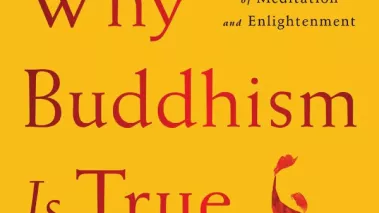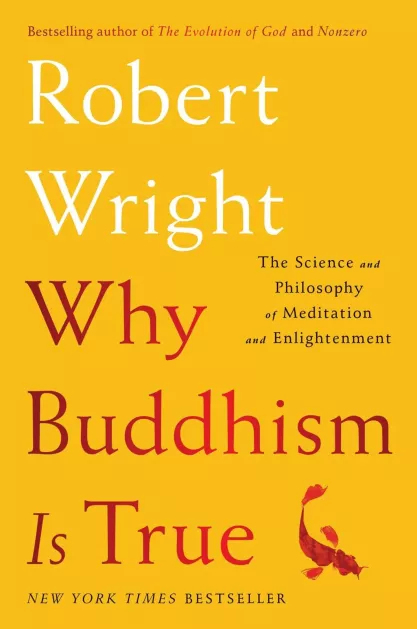Table of Contents
Twitter as meditative practice: ‘Why Buddhism is True’ by Robert Wright wins this month’s book award

I’m doing it again. Like last month’s, this book award will also be part of our “modular explanation of freedom of speech.”
Key Concept —
The “Pure Informational Theory” of Freedom of Speech: My primary and highly expansive justification for the value of freedom of speech can be stated as “knowing the world as it is is the arduous project of human knowledge, and we cannot begin to know the world as it is without knowing what people think, believe, or what they’re willing to say they think or believe and why. Therefore all speech is of some value because all speech conveys some amount of information. Because it is hard to judge in advance what information is particularly useful to know, the broadest possible protection of opinion is necessary.”
The winner of this month’s Prestigious Ashurbanipal award is “Why Buddhism is True” by Robert Wright.

I have been a huge fan of Robert Wright since reading his book “The Moral Animal” in the 1990s. It was the clearest and most thoughtful explanation of evolutionary psychology and how it applies to the actual life and decisions of Charles Darwin that I ever read. His follow-up book, “Nonzero: The Logic of Human Destiny,” is among the rare books that I have read more than four times, and is so filled with fresh thinking and insight, expressed in a clear and simple style, that it is a genuine pleasure to read.
I had — foolishly it turns out — assumed that writing a book about Buddhism would lead him to reconsider or even disavow his previous work on evolutionary psychology. While I don’t think the subjects are at all contradictory, I have previously seen people who become more spiritual likewise become more skeptical of hard-nosed topics like evolutionary psychology. I was, however, entirely wrong, and a lot of the book is dedicated to reconciling evolutionary psychology and Buddhism, which he does brilliantly — and, in my opinion, accurately.
The book is profound in its conclusions, masterful in its harmonizing of scientific thought and wisdom traditions (something that Jonathan Haidt and I have great affection for), while also managing to be funny, honest, and practical. It’s the kind of book I’ll be thinking about for the rest of my life.
Why “Twitter as meditative practice” may not be the absolute dumbest thing you’ve ever heard in your life
Last fall, I had the great pleasure of being able to join Robert Wright on his podcast, and I talked about how I’d been thinking of Twitter as a form of “meditative practice.” I know how odd this sounds as Twitter, with all its hot takes, oversimplifications, pile-ons, dunking, confirmation bias, and general nastiness, seems like the exact opposite of meditative practice, but I think that comes from a misunderstanding of what meditative practice is actually like.
I am going to break all sorts of Buddhist rules on how to talk about meditation; just like Robert Wright, I have to — for the sake of both simplicity and clarity. Also, like Wright, I do not think of myself as a Buddhist, just someone who has, after spending a lot of time meditating and studying the Western brand of Buddhism, been greatly impressed by the tradition’s inherent wisdom about human nature and our minds.
So what kind of rules am I referring to? Well, for example, in meditation circles it’s discouraged to think of yourself as “trying” to do something when you’re meditating. “There is no wrong way to meditate” is something I heard when I first started poking my nose into meditation. While I understand what they’re getting at — namely, that you can bring meditation to any state of mind — if you, for example, decide to spend your meditation retreat carefully going over your “to-do” list in your head and trying to memorize what you need to add to it later, you aren’t, well, doing it right. I studied a Western-oriented school of Buddhism that is focused on taking Buddhist practices out of the monastery and into the “real world.” Like many others in meditation, we were taught to focus on our own breathing and when a thought arises to lightly label it as “thinking,” then return to following the breath.
When people are new to meditation they can often be blown away by how “loud” their minds are.
When people are new to meditation they can often be blown away by how “loud” their minds are. It is often likened to a wild horse, but I think that image is not wild enough. To me it’s more like watching a hundred wild horses who have consumed amphetamines, while very loud music is blaring, with strobe light flashes of things your brain is worried about forgetting, while watching a slideshow of embarrassing moments you have had in your life, while being aware that your shoulder really hurts and your calves really itch, all while wondering “am I just bad at this?”
After a lot of practice, you get a little bit more distance between you and the thoughts. Buddhists call this nonattachment, but I’m okay with simply calling it detachment. Detachment, like objectivity, is not a state you can ever fully get to, but you can get closer to it through meditation. Over time you can see your thoughts as having something like agendas of their own. They are trying to get you to DO something — usually even when that task is as amorphous as “WORRY!” or as specific as “you really need to tell your coworker that you feel bad about the way you put that one thing in that one email three weeks ago.” You start to understand the old Buddhist mantra that “you are not your thoughts.” Your thoughts come to seem a little bit more like weather and, with a bit greater detachment, you can decide more carefully which to follow and which to let fizzle.
So how does this apply to Twitter?
I wrote a long time ago on HuffPost that Twitter is like the collective unconscious of the entire species. What I mean is that prior to the last two decades there has never been anything like a real-time/instantaneous way to check in on the largely unmediated immediate reactions of hundreds of millions (if not billions) of people around the planet. This is an extraordinary shift, and it's one of the reasons why Paul Krugman’s 1998 prediction that the internet would only have as much impact as a fax machine was such a colossally stupid idea. Martin Gurri is correct that social media is part of a “Fifth Wave,” with tremendously disruptive influence on every aspect of modern life, from government, to science, to even how we think about thinking.
And here’s one of the really weird things about meditating that Sam Harris really likes to emphasize: After meditating for a while, you start to realize that it seems like your thoughts don’t really come from anywhere, or at least not anywhere that’s easy to track down. They just kind of pop into existence like a virtual particle in a vacuum. By refocusing on your breath, this can be easier to see, and what you are trying to do is learn how to not necessarily follow the individual thought that arrives down the rabbit hole and through the labyrinth of other thoughts, emotional reactions, worries, and instincts it triggers.
Over time, I was taught to try to identify with whatever it is that exists that can actually view these thoughts from the outside. In other words, trying to cultivate a little bit of detachment where you watch your thoughts arise, explode, and insist on being noticed and followed, and you simply choose not to follow them.
You are not your thoughts = Twitter is not the world
I hope by now you see how this plays out on Twitter. You are playing the role of, well, the “you” that exists with the ability to observe your own thoughts — and tweets — that arise sometimes seemingly out of nowhere. If you want to have a long and happy life in an environment where you can be “canceled” for reacting the wrong way and saying so publicly, learning some amount of detachment from what those provocations are “telling you” to think is useful.
But I want people to understand that this is more than mere self-preservation. The collective brain we created in social media is surprisingly similar to the way our actual brain works, and if we can cultivate some amount of detachment, some greater willingness to simply observe what the tweet is saying in a broader sense, where it is trying to take you, and figure out what the person on the other side of that tweet may be thinking, trying to tell us, or, quite often, trying to tell themselves, we can get a lot more out of it.
Twitter is an experiment unlike any that existed in human history prior to the “information age.”
Twitter is an experiment unlike any that existed in human history prior to the “information age.” Historically, its primary parallel is the printing press, which was colossally disruptive, but didn’t have the same kind of scale and certainly nothing like the immediacy. What if we didn’t feel the need to crush the wrongthink on Twitter, and instead approached social media with a deep curiosity about not only what we are thinking and why, but also what everyone else is thinking and why (keeping in mind the gulf between what people are thinking and what they’re willing to say)? This is an unparalleled opportunity to learn profound, perhaps uncomfortable, truths not only about human nature but the emerging phenomenon of what human nature looks like when connected to billions of other unmediated minds.
This way of looking at speech and ideas led me to my Pure Informational Theory of Free Speech, which I defined above and discussed in detail previously with respect to censorship in the early days of COVID-19. And it’s also a reminder to tell everyone to pre-order Jonathan Rauch’s upcoming book about free speech and how we know things, “The Constitution of Knowledge.” (It’s coming out in June, more proof that epistemology is going to be HOT in 2021!)
One especially useful meditation technique for Twitter is to be aware of “feeling tones.” This is noticing how a pervasive body-wide sensation can seem to emanate out of certain kinds of thoughts. Reminding yourself purposefully of a loved one, for example, while meditating can, quite literally, feel like a ripple of warmth spreading across your chest. Likewise, remembering an embarrassment or humiliation, even from decades ago, can also create a nearly instantaneous body-wide reaction. Even thinking about thinking about it, my hands are tensing and my neck is getting hot. And once you approach those feelings with curiosity rather than a desire to drive them away, interestingly, they lose some of their viscerality and you become less fearful of them arising again.
So, I am trying to bring this way of looking at the world to Twitter. There are some things that people can tweet that make us furious, sad, hopeless, or panicked. But rather than answering right away, sit with that feeling for a moment and try to figure out what it tells us about ourselves, about the other person, about the dynamics and incentives of this peculiar medium, and what it is you or the other person may not be saying. It’s a rich and complicated world, and you can learn a lot more with that approach than simply trying to shut down whatever sparked a reaction.
Unfortunately, given how fast everything is moving, I fear that we will fail to realize that we can learn far more about human nature — what’s really going on in people’s heads, underlying currents, and things that people are and are not willing to say — than ever before. The instinct against learning this is deep: As with an unwanted thought, the compulsion to make the tweet go away is likely to win and we will be deprived of this learning opportunity because we are more concerned with placing a primitive idea of reality as a relatively small number of us believe it should be over the opportunity to learn something much more strange, intricate, and profound about the way the world really is.
My Prestigious Jack Kirby award goes to the meditation app Headspace
As far as I can tell there are three dominant meditation apps currently in circulation: Calm, Headspace, and Sam Harris’ Waking Up. I have tried all three. For several months now, I’ve been trying to work with Waking Up, and, even though I think that there is some profound wisdom in his approach to teaching meditation, I can’t recommend it. Maybe it will work better for people who have far more experience with meditation than I do, but it ends up being too intellectual and too talkative for me. I was trying to do one of the daily meditations the other day and I swear there was talking for maybe 7 1/2 of the 10 minutes I had.
My other issue with Waking Up is that it has a very clear idea of what your meditation experience should be like. Sam Harris doesn’t believe in free will, and while that’s a very interesting discussion, when you hear in meditation after meditation that when you go looking for yourself you can’t really find yourself, that eventually you “become someone who feels as if they’re meditating without a head,” or that thoughts just seem to arise in the “cloud of consciousness” as all things do, it’s hard for a natural contrarian like me not to just start resisting the lesson. It’s also a conflict of disciplines. The way I was taught meditation, you come to relate more with whatever it is that is viewing your thoughts. You come to think of the part that watches as “you,” so it doesn’t really seem persuasive to me that this means “I” don’t really exist. In fact I think cultivating the ability to step away from your thoughts and watch them arise and not be dragged by your teeth by every feeling or thought that you have makes your will feel more “free” and the person that you are feel more real, not less.
I haven’t spent enough time with Calm to figure out my overall opinion of it, but I have spent enough time with Headspace to say that Headspace gently and carefully teaches you some things that I wish I knew about meditation going in. Even in its first 10 “lessons,” it shows you things that took me years to figure out on my own. Is something lost by not figuring it out on your own? Perhaps, but it did feel like it was mostly telling me the wasteful misconceptions, rather than the more profound truths that may be discovered after doing this for a long time.
I recommend Headspace. Don't expect to get anything out of it for at least the first couple of weeks. As Tim Ferriss likes to recommend, the minimum effective dose of meditation is probably at least two weeks. And if you can go to a meditation retreat, give it a shot.
The Fats Waller award goes to “Getz/Gilberto” (a.k.a the “Girl From Ipanema” album)

Pretty much every cool cat above a certain age owns this classic album by Stan Getz and João Gilberto that popularized the genre of “bossa nova” all over the world. It’s a gorgeous and soothing window into a different time and even has a little bit of the flavor of one of my favorite countries in the world, Brazil. How does this relate to meditating? Well, a recurrent problem in meditation is that you’ll get a song stuck in your head for hours, if not days. Robert Wright confesses that the song for him was “Feels Like the First Time” by Foreigner. Mine is often “Fresh Feeling” by the Eels. But my all-purpose song for getting other songs I don’t like out of my head is “The Girl From Ipanema,” specifically the version on this album. As reported in my first book, “Unlearning Liberty,” “The Girl From Ipanema” has proven so catchy and soothing that it can push any other song out of my head. It doesn’t always work anymore because my brain is ready for it, but it still is quite effective.
Which introduces a new problem: how do I get “The Girl From Ipanema” out of my head and start focusing on my breath again? Well, sometimes I can’t, and I’ve gotten used to just listening to it in the background. Indeed, once you start meditating, the idea that the music that is playing in your head isn’t really playing in your head can seem simply untrue, as it can be so clear and rich. But often, if we don’t engage with it, it eventually will fade on its own… or not. Just focus on your breath and let your brain sing to you.
Recent Articles
Get the latest free speech news and analysis from FIRE.

VICTORY: Court vindicates professor investigated for parodying university’s ‘land acknowledgment’ on syllabus

Can the government ban controversial public holiday displays?

DOJ plan to target ‘domestic terrorists’ risks chilling speech
